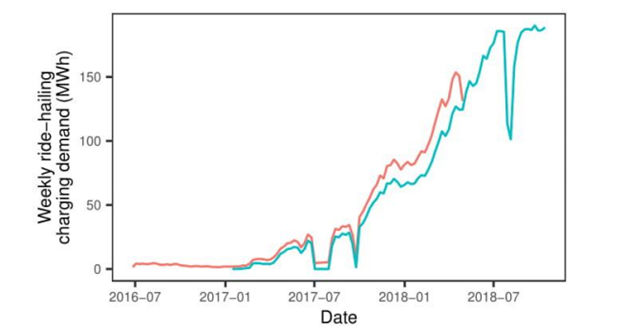News | PSR Researcher Alan Jenn Investigates Electric Vehicle Infrastructure Needs for Ride-Hailing Services in California
Stop the VideoNews

PSR Researcher Alan Jenn Investigates Electric Vehicle Infrastructure Needs for Ride-Hailing Services in California
Monday, June 7, 2021
Given its concerns over climate change and environmental justice, the State of California is mandating a transition to electric vehicles over the next decade and a half. The recent Clean Miles Standard aims to increase zero-emission miles per passenger and decrease greenhouse gas emissions by setting up new regulations for transportation network companies (TNCs)—also known as ridesharing companies. One of the largest ridesharing companies, Lyft, has already committed to a target of 100 percent electric vehicles by 2030. The even larger TNC, Uber, has pledged to become a globally zero-emission company by 2040. Such a rapid and large-scale shift to electric vehicles requires exhaustive planning on how to best deploy electric vehicle charging infrastructure. Alan Jenn, Assistant Director at the Institute of Transportation Studies at the University of California, Davis, investigates charger infrastructure requirements for the transition to electric fleets in the PSR-funded project, “Charging Forward: Deploying Electric Vehicle Infrastructure for Uber and Lyft in California.” The study estimates charging demand by using empirical data directly from Uber and Lyft. It examines the tradeoffs and costs of electric vehicle usage and increased charger demand not only to cities, but also to TNC drivers and employees.

“Figure 1: Growth in electricity demand from electric vehicles driven on Uber and Lyft services over time”
Few studies have yet to focus specifically on ridesharing services and what their large-scale transition to electric vehicles means for public charging infrastructure. While the current literature covers general public EV charging infrastructure, charging behavior, benefits to consumers, and coinciding environmental and economic benefits, the PSR researchers fill the gap by focusing their investigation on ride-hailing electric vehicles. Their case studies for charger installation are based in areas dense with light-duty vehicles: Los Angeles, San Diego, and the San Francisco Bay Area. The researchers explain that focused quantitative analysis is necessary in the ridesharing space because vehicles employed in ridesharing services travel significantly more than the average personal vehicle. It follows that the charging demands for ridesharing vehicles are higher, and the high amounts of travel by ridesharing EVs will impact public charging infrastructure requirements. Research and planning are crucial in order to efficiently deploy chargers that can meet the public’s transportation needs. Having the right infrastructure in place can help further encourage and facilitate the use of electric vehicles.
The researchers make sure to consider the tradeoffs and costs to drivers in the transportation network companies, and how adjustments in behavior might further impact the deployment of chargers. Their WIRED (Widespread Infrastructure for Ride-Hailing EV Deployment) model places a value on the time drivers must spend on charging activities, including the amount of time it takes to travel to a charger and how long it takes to charge the vehicle. For drivers, these may be considerable costs since they must take time away from picking up passengers and spend idle time charging. With this consideration, the researchers were interested in discovering which chargers were most effective in terms of how quickly they can charge a car. Under the assumption that rideshare drivers’ charging behavior is mostly dependent on public charging infrastructure, it is important to consider costs and preferences in order to avoid deploying charging infrastructure that introduces further obstacles to use.
Their results demonstrate that the necessary ratio of chargers to electric vehicles is around 10 times higher for those who drive for Uber and Lyft compared to the general public of electric vehicle owners. This significant demand calls for increased attention on the electrification of ridesharing fleets and its cascading impacts on public charging infrastructure and charger types. The researchers are continuing their work by integrating existing stations and projections of public infrastructure in their future studies; but they stress that more attention from other organizations and entities is crucial. This research is intended to lay the foundation and provide important context for further analysis; but planning and problem-solving in full requires cooperation from stakeholders including ride-hailing companies, regulatory agencies, and urban planners.
News Archive
- December (1)
- November (6)
- October (4)
- September (2)
- August (3)
- July (4)
- June (3)
- May (7)
- April (8)
- March (11)
- February (8)
- January (7)
- December (7)
- November (8)
- October (11)
- September (11)
- August (4)
- July (10)
- June (9)
- May (2)
- April (12)
- March (8)
- February (7)
- January (11)
- December (11)
- November (5)
- October (16)
- September (7)
- August (5)
- July (13)
- June (5)
- May (5)
- April (7)
- March (5)
- February (3)
- January (4)
- December (4)
- November (5)
- October (5)
- September (4)
- August (4)
- July (6)
- June (8)
- May (4)
- April (6)
- March (6)
- February (7)
- January (7)
- December (8)
- November (8)
- October (8)
- September (15)
- August (5)
- July (6)
- June (7)
- May (5)
- April (8)
- March (7)
- February (10)
- January (12)















